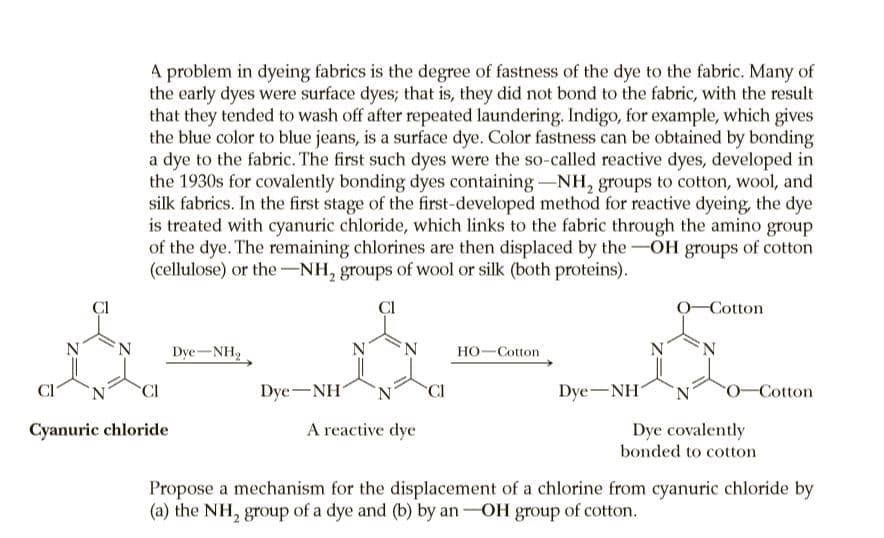A problem in dyeing fabrics is the degree of fastness of the dye to the fabric. Many of the early dyes were surface dyes; that is, they did not bond to the fabric, with the result that they tended to wash off after repeated laundering. Indigo, for example, which gives the blue color to blue jeans, is a surface dye. Color fastness can be obtained by bonding a dye to the fabric. The first such dyes were the so-called reactive dyes, developed in the 1930s for covalently bonding dyes containing-NH, groups to cotton, wool, and silk fabrics. In the first stage of the first-developed method for reactive dyeing, the dye is treated with cyanuric chloride, which links to the fabric through the amino group of the dye. The remaining chlorines are then displaced by the-OH groups of cotton (cellulose) or the-NH, groups of wool or silk (both proteins). CI -Cotton Dye-NH, Но-Сotton N' CI CI Dye-NH CI Dye-NH 'N. 0-Cotton Cyanuric chloride A reactive dye Dye covalently bonded to cotton Propose a mechanism for the displacement of a chlorine from cyanuric chloride by (a) the NH, group of a dye and (b) by an-OH group of cotton.
A problem in dyeing fabrics is the degree of fastness of the dye to the fabric. Many of the early dyes were surface dyes; that is, they did not bond to the fabric, with the result that they tended to wash off after repeated laundering. Indigo, for example, which gives the blue color to blue jeans, is a surface dye. Color fastness can be obtained by bonding a dye to the fabric. The first such dyes were the so-called reactive dyes, developed in the 1930s for covalently bonding dyes containing-NH, groups to cotton, wool, and silk fabrics. In the first stage of the first-developed method for reactive dyeing, the dye is treated with cyanuric chloride, which links to the fabric through the amino group of the dye. The remaining chlorines are then displaced by the-OH groups of cotton (cellulose) or the-NH, groups of wool or silk (both proteins). CI -Cotton Dye-NH, Но-Сotton N' CI CI Dye-NH CI Dye-NH 'N. 0-Cotton Cyanuric chloride A reactive dye Dye covalently bonded to cotton Propose a mechanism for the displacement of a chlorine from cyanuric chloride by (a) the NH, group of a dye and (b) by an-OH group of cotton.
Organic Chemistry
8th Edition
ISBN:9781305580350
Author:William H. Brown, Brent L. Iverson, Eric Anslyn, Christopher S. Foote
Publisher:William H. Brown, Brent L. Iverson, Eric Anslyn, Christopher S. Foote
Chapter22: Reactions Of Benzene And Its Derivatives
Section: Chapter Questions
Problem 22.29P
Related questions
Question

Transcribed Image Text:A problem in dyeing fabrics is the degree of fastness of the dye to the fabric. Many of
the early dyes were surface dyes; that is, they did not bond to the fabric, with the result
that they tended to wash off after repeated laundering. Indigo, for example, which gives
the blue color to blue jeans, is a surface dye. Color fastness can be obtained by bonding
a dye to the fabric. The first such dyes were the so-called reactive dyes, developed in
the 1930s for covalently bonding dyes containing-NH, groups to cotton, wool, and
silk fabrics. In the first stage of the first-developed method for reactive dyeing, the dye
is treated with cyanuric chloride, which links to the fabric through the amino group
of the dye. The remaining chlorines are then displaced by the-OH groups of cotton
(cellulose) or the-NH, groups of wool or silk (both proteins).
CI
-Cotton
Dye-NH,
Но-Сotton
N'
CI
CI
Dye-NH
CI
Dye-NH
'N.
0-Cotton
Cyanuric chloride
A reactive dye
Dye covalently
bonded to cotton
Propose a mechanism for the displacement of a chlorine from cyanuric chloride by
(a) the NH, group of a dye and (b) by an-OH group of cotton.
Expert Solution
This question has been solved!
Explore an expertly crafted, step-by-step solution for a thorough understanding of key concepts.
This is a popular solution!
Trending now
This is a popular solution!
Step by step
Solved in 2 steps with 1 images

Recommended textbooks for you

Organic Chemistry
Chemistry
ISBN:
9781305580350
Author:
William H. Brown, Brent L. Iverson, Eric Anslyn, Christopher S. Foote
Publisher:
Cengage Learning

Organic Chemistry: A Guided Inquiry
Chemistry
ISBN:
9780618974122
Author:
Andrei Straumanis
Publisher:
Cengage Learning


Organic Chemistry
Chemistry
ISBN:
9781305580350
Author:
William H. Brown, Brent L. Iverson, Eric Anslyn, Christopher S. Foote
Publisher:
Cengage Learning

Organic Chemistry: A Guided Inquiry
Chemistry
ISBN:
9780618974122
Author:
Andrei Straumanis
Publisher:
Cengage Learning
